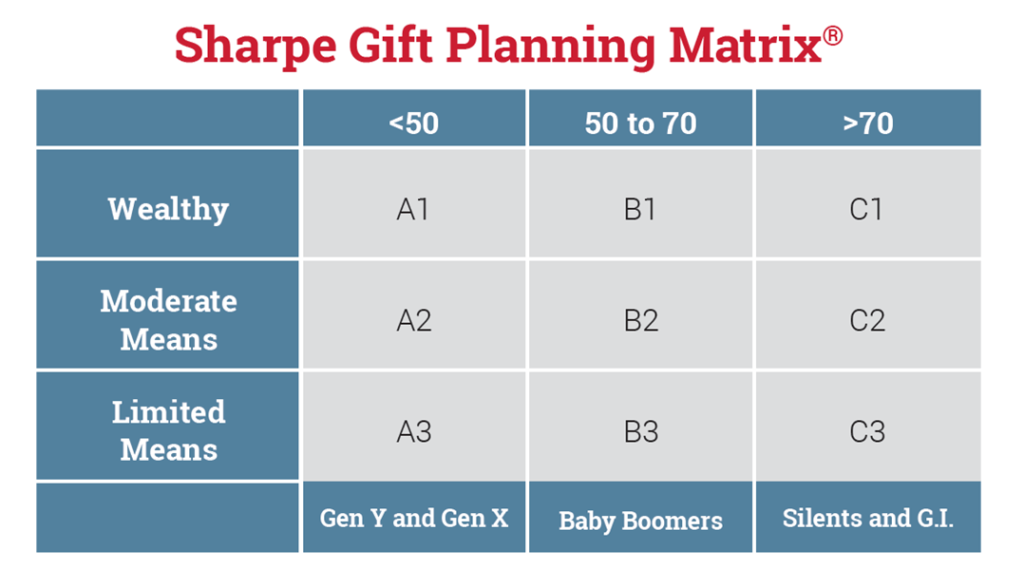As a fundraiser, your most precious and important asset is your donor data. Understanding how to best use it is another matter. It is extremely important to segment your donors into groupings based on your charity’s priorities of fundraising. Sharpe uses the donor matrix shown below to help charities with their planning, budgeting, resource allocations and marketing.
This segmentation gives precise numbers of the donors most likely to consider major or capital campaign gifts while also identifying the donors who most likely will consider planned gifts (both current and deferred). You can then determine the personnel needed to achieve goals, determine the marketing strategies that should be employed and set budgets and schedules for communications, events, site visits, case statements, etc. Further, using this segmentation will help assign caseloads to your board and executives, other leadership, field staff and possibly even volunteers engaged in fundraising efforts.
Additionally, this segmentation enables you to determine specific marketing strategies and tactics. For example, those donors who are the youngest are most likely to use email, social media, websites and other online connections to maintain their relationship to your charity. On the other hand, the oldest donors may not even be connected digitally and would prefer contact via telephone and mail. Those two methods have been their lifelong means of making gifts and financial decisions, so employing their communication preferences will generate larger gifts for your charity.
Finally, segmentation enables effective targeted research or “micro” analysis to identify specific donors for personal connections. That is where Artificial Intelligence plays its most vital role. Sharpe’s AI can be used to reduce the massive amount of human resources needed for such research and identify key donors who meet the criteria for a desired outcome. This AI output generates caseload assignments for a field staff fundraiser able to determine priorities of contact.
As an example, if a charity’s focus is a capital campaign funded with major gifts, the desired outcome could be finding those who can make large gifts of $100,000 or more. The AI would identify the best candidates for that goal. For large bequests and other deferred gifts, AI would identity the best candidates to be approached for their ultimate gifts. AI shortens the time required to make key decisions about allocating resources, building relationships, marketing promotions and using limited budgets for the most productive outcomes. Ongoing AI analysis promotes the long-term effective use of all available resources to fulfill the mission and goals of a charity.
Nothing is more critical than the understanding and effective utilization of donor data!
Additional resources
Sharpe Group has additional information to help you understand how to use donor data and how predictive analytics can impact your fundraising capabilities.
- Read the blog “The Importance of Donor Data” by Lewis von Herrmann posted on Aug. 18, 2021.
- Read “Artificial Intelligence & Donor Insights” by Dennis Koerner, PhD, published in May/June 2021 issue of Sharpe Insights.
- Access the recording of a free webinar, “Making the Most of Donor Data,” presented on Aug. 25, 2021.
Find out how your donor data quality compares to that of other nonprofit organizations by responding to our Donor Data Health Checkup questionnaire. Be sure to share your contact information including organization name to receive a report. ■
 Lewis von Herrmann, CFRE, is a senior consultant with Sharpe Group based in our Southern region. He has more than 45 years of experience in charitable fundraising, specializing in developing both major and planned giving programs.
Lewis von Herrmann, CFRE, is a senior consultant with Sharpe Group based in our Southern region. He has more than 45 years of experience in charitable fundraising, specializing in developing both major and planned giving programs.


